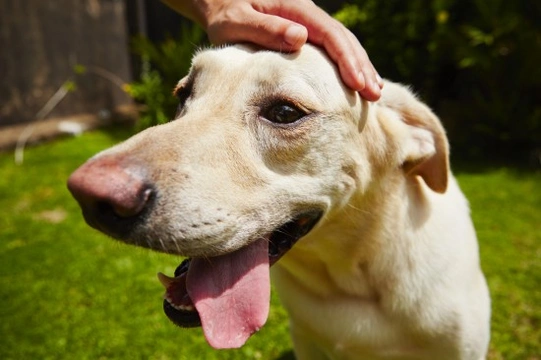
Is your dog head-shy?
The body language of dogs is very comprehensive, expressive, and honest. “Honest” in terms of being relatively easy to read when you know the various signals that dogs give out, and in terms of the fact that what your dog is “saying” to you is what they mean, and you can rely on the cues that they demonstrate to dictate their intentions.
As well as showing what they intend to do by means of their body language, dogs can also tell you how they are feeling, and if they are happy, comfortable, and feel safe. For this reason, it can be perturbing for the dog owner to find that their dog flinches or shies away from them when they go to touch the dog’s head, as if they are expecting to be hit, or face a negative experience.
This is referred to as being head-shy, and while it can manifest in a range of ways, such as flinching, pulling away or turning their head out of your range, it is almost universally a submissive behaviour. Sometimes this is indicative of prior poor treatment or an expectation to be hit or hurt when you approach the head, but it may also have a medical reason behind it.
Whatever the reason behind your dog’s head-shy behaviour is, it is important to try to get to the bottom of it. Read on to learn more.
Your dog’s background
If your dog was owned by someone else before you or has an uncertain history, being head-shy is often an indication that the dog was used to being struck on the head, or at least being threatened with being struck. It should go without saying that you should never hit or threaten to hit a dog on the head, and if your dog has been conditioned to expect this, it can be hard to undo that expectation.
Try to find out about your dog’s history, and if there is an obvious reason why they might be head-shy.
Veterinary causes of head shyness
If you have owned your dog since they were young and/or head-shyness is a recent behaviour that your dog has started to exhibit with no good reason, your first step should be to get your vet to perform some tests and a check-up on your dog. Head shyness is not always a sight of a learned fear, but might be due to a painful or irritating problem with the head that causes pain when they are touched.
Your vet will likely check your dog’s vision, check for ear mites, and look for signs of any injury or problem with the face, head and neck that may explain sudden flinching.
Ducking the head
If your dog is apt to duck their head when you reach your hand out to them, you might read this as head-shyness when in fact that is not the case. Simply dropping the head and eyes when you go to touch your dog indicates trust and submission, without fear. It is a passive behaviour to the alpha, and an act of deference that lets you know that your dog invites your touch, on your terms.
Your dog may or may not avoid eye contact when you do this, but unless your dog flinches or shies away too, this is unlikely to indicate head-shyness.
Understanding your dog’s body language
Take your dog’s body language as a whole when trying to interpret what they are saying, and you will pick up a whole wide range of cues.
If you approach your dog too fast or too enthusiastically, this may unnerve them, so encourage your dog to come to you instead. Anxious, shy or timid dogs will often lie down or appear to try to make their bodies smaller when you approach, as a submissive gesture that does not quite cross the line into anxiety.
A dog that is actually frightened or anxious will hide their tummy, lie close to the ground, tuck their tail in and flatten their ears, all of which will commonly accompany head-shyness or flinching when you reach for the head.
How to respond to head-shyness in your dog
If your dog is genuinely head-shy, changing your movements and actions when you approach your dog will help. Instead of towering over your dog and reaching down to pat them on the head, crouch down to your dog’s level and offer your hand palm-up. Do not pass your hand across the dog’s line of vision to the top of the head; stroke their chest or neck instead until they feel comfortable.
Always move slowly and gently, and speak reassuringly to your dog while you approach and when you are touching them.
Over time, patience, a quiet demeanour and a reassuring presence for your dog should serve to re-train them not to fear a touch to the head, especially if you encourage your dog to come to you on their terms for a fuss, and offer treats as a reward!



